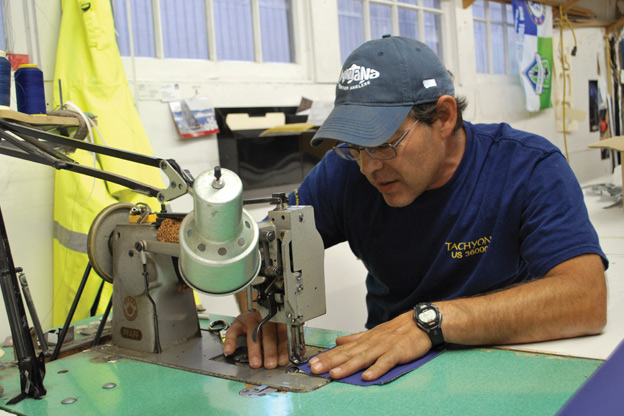 “The colors live a remarkable life of their own after they have been applied to the canvas.”
“The colors live a remarkable life of their own after they have been applied to the canvas.”
-Edvard Munch
The grey of the Pacific Northwest November is upon us, and plenty of boat owners are busting out the canvas covers to cocoon their beloveds from the elements. Whether you have a motoryacht with a Bimini top or a sloop with a sail cover, nothing makes a boat pop like bright, pristine canvas work. Most of us take the dutiful canvas aboard for granted, and the gradual decay due to UV light, salt, and mold are considered inevitable. Still more of us grumble at the cost of the new replacement after a couple of years and chalk it up as one of the many hidden expenses of boating. When shopping around, we tend to look for the cheapest price, scribble a few measurements on a piece of paper, and get it over with. “As long as it doesn’t look awful,” tends to be the pervasive attitude.
As it turns out, the circle of life ritual of canvas does not have to spin every few years if you follow some pretty basic maintenance steps. What’s more, there is a pretty big difference between somebody who can cut canvas and a craftsman who goes the distance to create a piece designed for your boat and your lifestyle to last as long as possible. For this iteration of Ask the Experts, we turn to Shaun Breese of Breezy Canvas and Upholstery for the ins and outs of the marine canvas world.
Q: Let’s say I’m looking at canvas options for my boat. Is there a big spectrum of materials in terms of price range
and quality?
No, not with what we do. There are a lot of different clear products you can use and there is a huge range of pricing and quality there, but most fabric we’ll use is Sunbrella. There are other fabrics, but we don’t use them very much. The exception is if you want a white, vinyl-like product. Then we use Stamoid. But that’s for white stuff, in which case I’ll steer the client away from Sunbrella.
Q: One hears a lot about Sunbrella. What’s so great about it?
Sunbrella is an acrylic fiber, so it just doesn’t rot, and we use an acid dye so it holds its color really well in the UV. You can get stuff on it that will mold, but the fabric itself will not mold because it is a plastic. It doesn’t handle chaff or rubbing very well, so for anything that is touching it, you need to reinforce it or add product.
Sunbrella also breathes to let the water vapor come off, so it isn’t designed to be 100% waterproof in that way. Waterproof material will actually trap the water vapor and condense on the inside, promoting mold and rot. So Sunbrella will keep the vapor off, while other more waterproof materials will seal mildew and stuff on the inside.
Sunbrella is the best product for most applications. Stamoid is a marine vinyl and doesn’t tend to shrink. It’ll last a long time. You can blast it and wipe it off to clean it, rather than a fabric which needs a bit more careful handling. But they look different. Stamoid has that plastic-y look, while canvas just looks nice.
Q: You touched on maintenance a bit. What can boaters do to keep their canvas alive and well?
Keep it clean! A lot of people throw it up and don’t touch it for years. It should be cleaned and re-treated. If you wash it with soaps, you need to re-treat it with a waterproofing agent. I recommend a wash like that every year or so.
Q: Yeah, it seems like a lot of folks have the mentality that canvas has a pretty short lifespan and you should just replace it when it goes out.
When you look at the price tag for these labor-intensive pieces, you really should want to take care of it. Cleaning is a process. If it is mildew-y, how bad is it? If it’s old, what does it need? If the canvas looks pretty good, a little soap and water followed by some re-treatment and you’re done. Enzyme cleaners are great because they eat mildew off.
Anything to avoid scrubbing–never scrub Sunbrella. Again, it’s chafe. Sunbrella doesn’t like chafe. Scrubbing Sunbrella breaks the fibers down and it gets kind of velvety and doesn’t bead off the water anymore. Just like Gore-Tex jackets, you want that smooth finish that sheds the water.
Q: So no steel wool?
Yeah, and stiff scrub brushes are a no-go. People shouldn’t take a pressure washer to it either because that really opens the fibers up. Don’t treat it too roughly, it likes enzymes and vinegar and water treatment to eat the mold off instead of scrubbing it off. Then you can go over it with a really light brush just to loosen the dirt. Then hit it with the hose and you’re set. I like to use a fingernail scrub brush with ¾” bristle, not too harsh, to get in there a little bit. Bleach is a last resort because it really hurts the threads.
Q: What about the binding materials?
I use Sunbrella bindings. Some guys use plastic or other bindings, but I use Sunbrella so it ages with the rest of the fabric. There are all kinds of snaps, but that is a pretty personal thing. People have all kinds of pet peeves and preferences.